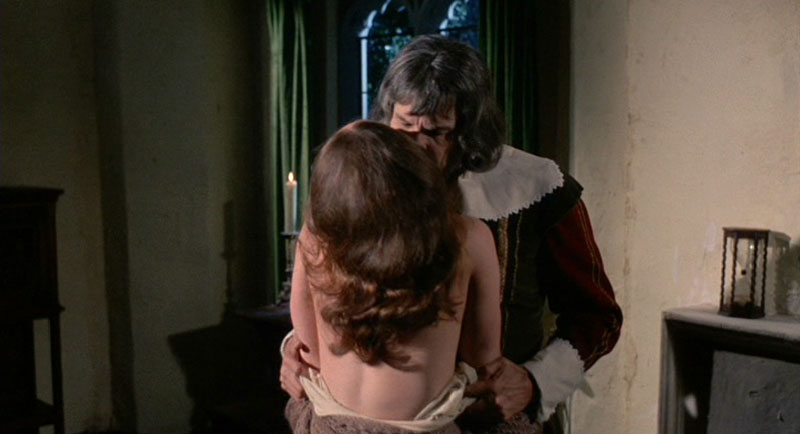
Vincent Price excels as Matthew Hopkins, the self-proclaimed Witchfinder General. Hopkins is a man who exploits the superstitions and faith of East Anglia in order to fulfill his own appetites for power and sex. Michael Reeves’ final film begins as a more traditional American International Pictures outing, then segues into the Western genre. This duality is central to the moral poles represented by Price’s antagonist and Ian Ogilvy’s heroic Richard Marshall.
Witchfinder General (1968) opens similarly to Frankenstein Created Woman (1967) with a brutal sequence of a public hanging. From there Reeves focuses primarily on Price’s sadistic operations of torture and exploitation. Progressively, spectacles become more and more shocking. These spectacles of horror culminates with the rape of Sara Lowes (Hilary Dwyer), Marshall’s wife to be. The actions of Price and his cohorts recall the kind of mindless marauding one sees predominantly in Euro-horror films of this period where the central theme is that, while society openly condemns such acts of violence, society itself is complicit for having enabled circumstances for this sort of exploitation.
After this prolonged first act, Reeves and co-screenwriter Tom Baker throw us headlong into the Western genre’s world of black and white morality. Now Richard Marshall swears vengeance on Hopkins and begins to hound him across England. As the English Civil War rages on in the background we are treated to set pieces that could have been torn straight from Sergio Leone’s westerns as these two mean hunt and evade one another. Marshall, notably, is a Roundhead fighting Royalists for a more democratic society. Meanwhile, Hopkins represents the most fundamentally corrupt kind of opportunist that is unique to situations of this degree of political turmoil. In Witchfinder General revenge becomes justice, a concept that is essential to the Western.
In the final act of Witchfinder General Marshall exacts his revenge, chopping Price’s Hopkins up with an axe in one of the most cathartic scenes I have even encountered. The image of Marshall wielding the axe matches any of the scenes of violence perpetrated by Hopkins and his followers. This visual unity suggests that the single-mindedness of Marshall’s quest has, in turn, corrupted him. In this way Hopkins wins even in death.
WItchfinder General is such a product of the sixties. It’s prophetic of Manson and Nixon while recalling figures such as George Wallace, Lyndon B. Johnson, and Senator McCarthy. The horrors of the old world, the world that allowed Hitler and WWII, have, despite the best efforts of a younger generation, continued to corrupt the world at large. This may seem a tad histrionic, but the allusions are all there beneath the surface. Matthew Hopkins was a real person who did these very real, very terrible things. Telling that story this way in 1968 makes such a reading of the film compulsory. I only wonder if Tarantino had something similar in mind when he made Once Upon A Time In Hollywood (2019)?
